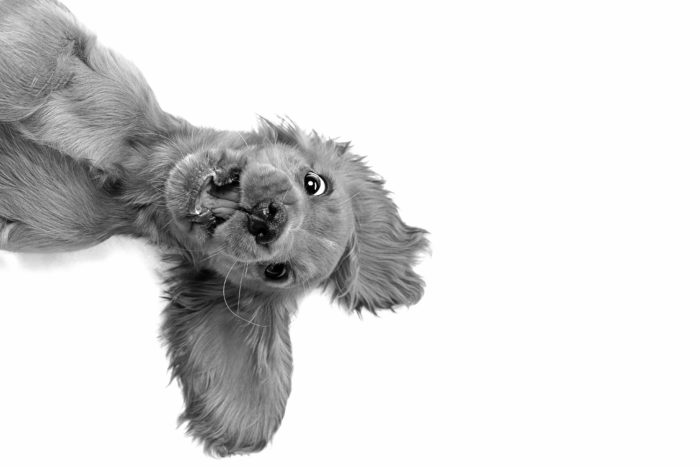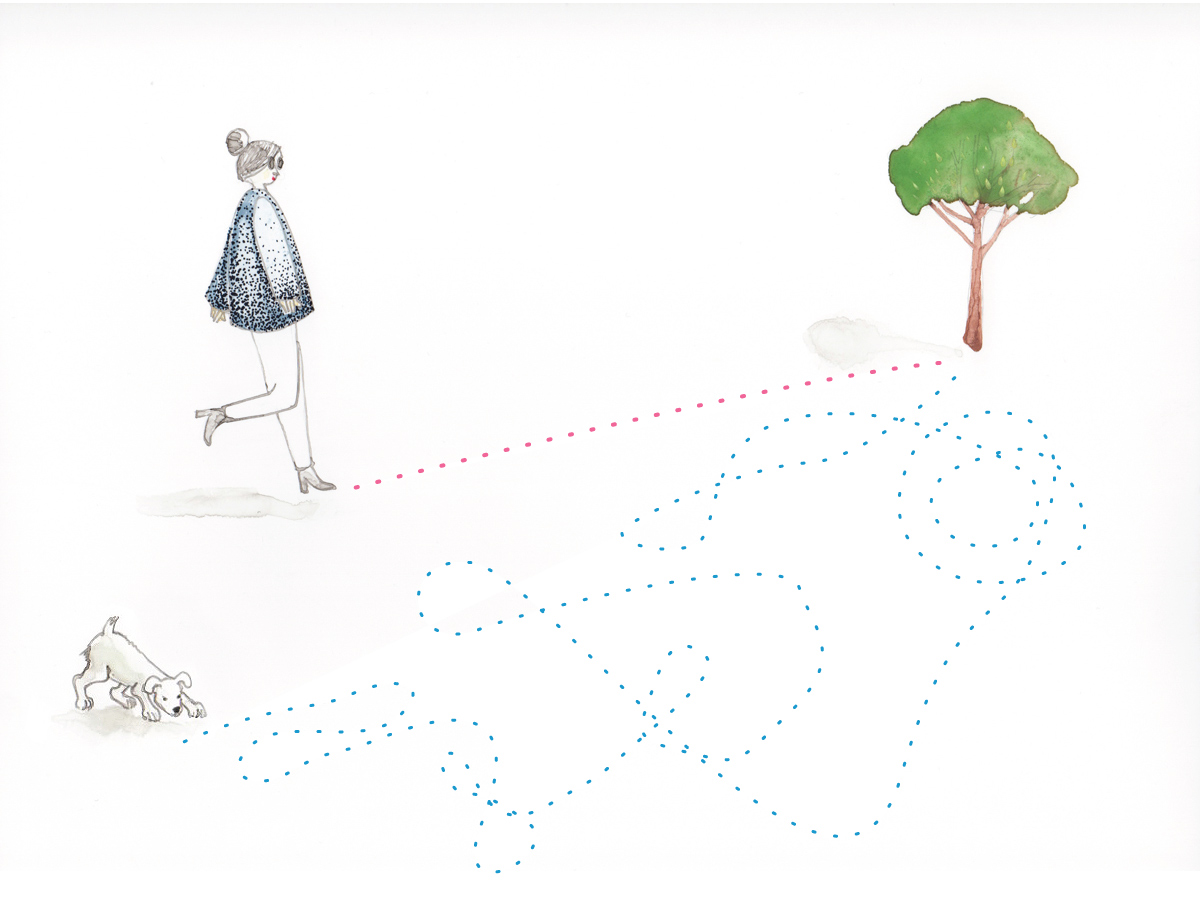
Picture an ape swinging from the jungle canopy making her way from point A to point B. A pod of dolphins leaping skyward out of the water and then splashing back in again, a frog hopping or swimming through a pond. How each of these animals moves on the earth is different. Swimming, swinging, slithering, soaring, hopping, no legs, two legs, four legs, wings, fins! Wow!
Imagine if you were required to keep up with a pod of sea lions, take a walk with a kangaroo or keep pace with a snail for a day. Hmm.
With that image fresh in your mind picture what it means to teach our four-legged puppy friends to walk with us. Let’s think about the finer points involved in teaching another species to amble along at our pace. To not do the things they want, but instead, pay attention to us.
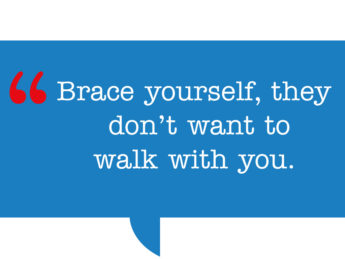 Does a dog naturally walk in a straight line the same way you do? No. A dog will move forward in different directions, often making turns and big circles, choosing not to follow a sidewalk or a well-worn path but rather, their nose!
Does a dog naturally walk in a straight line the same way you do? No. A dog will move forward in different directions, often making turns and big circles, choosing not to follow a sidewalk or a well-worn path but rather, their nose!
So this is the first thing to consider when we complain about unruly pups on leash. How are we going to interest our dog to walk this way?
The answer is little by little. First building a foundation and then adding more and more layers or pieces of the puzzle. Strategically, thoughtfully and with compassion and know-how. Teaching specific things one before the other, as the puppy is ready and as you have prepared him for the next lesson to be learned. This is how you would want to be taught, isn’t it?
In my freshpuppy course, I teach polite walking in Puppy Level 3. There are many other important pieces of the puzzle to put into place first. My students may ask “When do we cover leash walking?”, “How do I get my puppy to walk with me?”. Patience Grasshopper, all in good time.
Puppies pull, they lag, they quit, they may be scared, they may be jumping and biting. This is all normal! They are puppies. Brace yourself; they don’t want to walk with you! They would rather sniff, run or chase. They would rather rest in the cool grass or roll in the leaves or the snow. They would rather jump and run over there or over here! They would prefer to grab that leash and have a good game of tug with it. Can you blame them?
I urge you to consider this as well… imagine a stressed, overwhelmed, or over-stimulated puppy, who doesn’t know how to sit and who is not interested in checking in with you. Now try to teach that puppy to walk nicely on a leash with you. It’s probably not going to be too much fun for anyone.
There is a ton of other fun stuff for you to focus on with a puppy that will help you move toward teaching the pup to walk politely on the leash and to have a good time doing it. Prioritizing what is important to do and keeping your expectations realistic is so key. Let’s look at some of the foundation work (and play) that will help you gain the willing participation and focus you want from your puppy.
Socialization and exploration
Socialization and exploration trump polite walking by a long shot! Make sure your puppy is not scared of the world you expect them to navigate. This means a thoughtful and proactive socialization strategy. Use this robust list to help you accomplish this critical work.
Your dog’s ability to feel safe, curious, and capable to deal with complex environments has a direct impact on how well he will be able to walk on a leash with you.
Yoo-hoo!
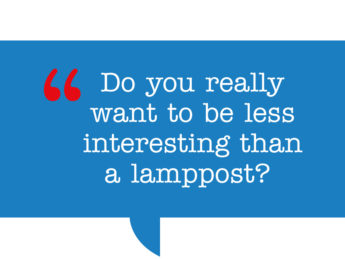 I’ve dubbed teaching a puppy to check in (with you) ‘Yoo-hoo’. Make it a habit to give your pup an incentive to check-in. I coach my students to supercharge their puppy with lots of tiny treats (about 5) in rapid succession for any sign of this behavior. I won’t prompt a pup for the ‘check in’ but when I get it you can be sure the pup is going to be reinforced handsomely! Teaching a puppy to check in from a distance is another valuable foundation behavior. You can teach this while doing long-line work. Read on.
I’ve dubbed teaching a puppy to check in (with you) ‘Yoo-hoo’. Make it a habit to give your pup an incentive to check-in. I coach my students to supercharge their puppy with lots of tiny treats (about 5) in rapid succession for any sign of this behavior. I won’t prompt a pup for the ‘check in’ but when I get it you can be sure the pup is going to be reinforced handsomely! Teaching a puppy to check in from a distance is another valuable foundation behavior. You can teach this while doing long-line work. Read on.
Follow me and long line work
Long lines are one of my favorite pieces of puppy equipment. I couldn’t imagine raising a pup without one. It is 20 to 40 feet worth of insurance; it is oodles of hands-free fun for you and your puppy. Nothing beats running around hither and yon in wide-open spaces with your pup using treats and toys. This is what dreams are made of! This is how you teach your puppy that you are more interesting than all of the things that are competing for his attention… squirrels, other dogs, leaves, or a lamppost. Do you really want to be less interesting than a lamppost? In addition to running, you can walk patterns, big squares, or serpentines reinforcing your pup for choosing to stay close by and stop when you do.
Walking together
My aim in writing about this is for you to stop and consider the complexity of teaching a puppy 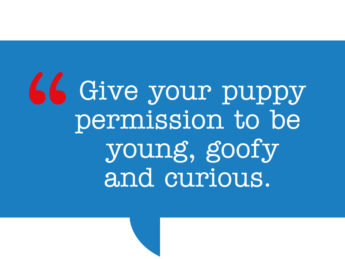 to walk on a leash. To encourage you to be patient with your puppy and yourself! Have fun together. Give your puppy time and permission to be young and goofy and curious. Start with these priority action plans. Little by little all of the pieces of the puzzle will start to fit together and the big picture is realized. Fast-forward 6 months from now and you have a pup that is starting to walk beautifully with you. Checking in, not pulling, and interested in exploring. Calm and confident.
to walk on a leash. To encourage you to be patient with your puppy and yourself! Have fun together. Give your puppy time and permission to be young and goofy and curious. Start with these priority action plans. Little by little all of the pieces of the puzzle will start to fit together and the big picture is realized. Fast-forward 6 months from now and you have a pup that is starting to walk beautifully with you. Checking in, not pulling, and interested in exploring. Calm and confident.
Raising an outstanding canine citizen is not a one-way street. It is more like a 10-lane highway. It’s not all about what we want. We have to learn and care about what our dog wants and needs. I know when my dog is enjoying the learning process. I also know the signs when it is not working for her. I pay attention and change gears when her head is not in the game. My goal is to make the experience fun and successful.
I feel like I will never be done learning things and teaching my dog new things. I recently learned that the name of that motion used by some apes that swing with their arms from the jungle canopy is called brachiation. So cool!
An additional thought…
As a side note, is it right to expect our dogs to always want to walk where we walk? I don’t think so! Neither does your dog. We need to provide outings where we take our dog’s lead (safety in mind) as they explore a field, a trail, a park, the shore, or the sidewalk. Letting them do what they want and go where they want. Imagine never being able to do that yourself!
When I go out with my dogs the walk will consist of different facets. The ‘let’s walk walk’ or the ‘sniff walk’. These days I am always on at least a 15-foot-long line, you can almost always find me fast walking behind my dog as she walks her way.

